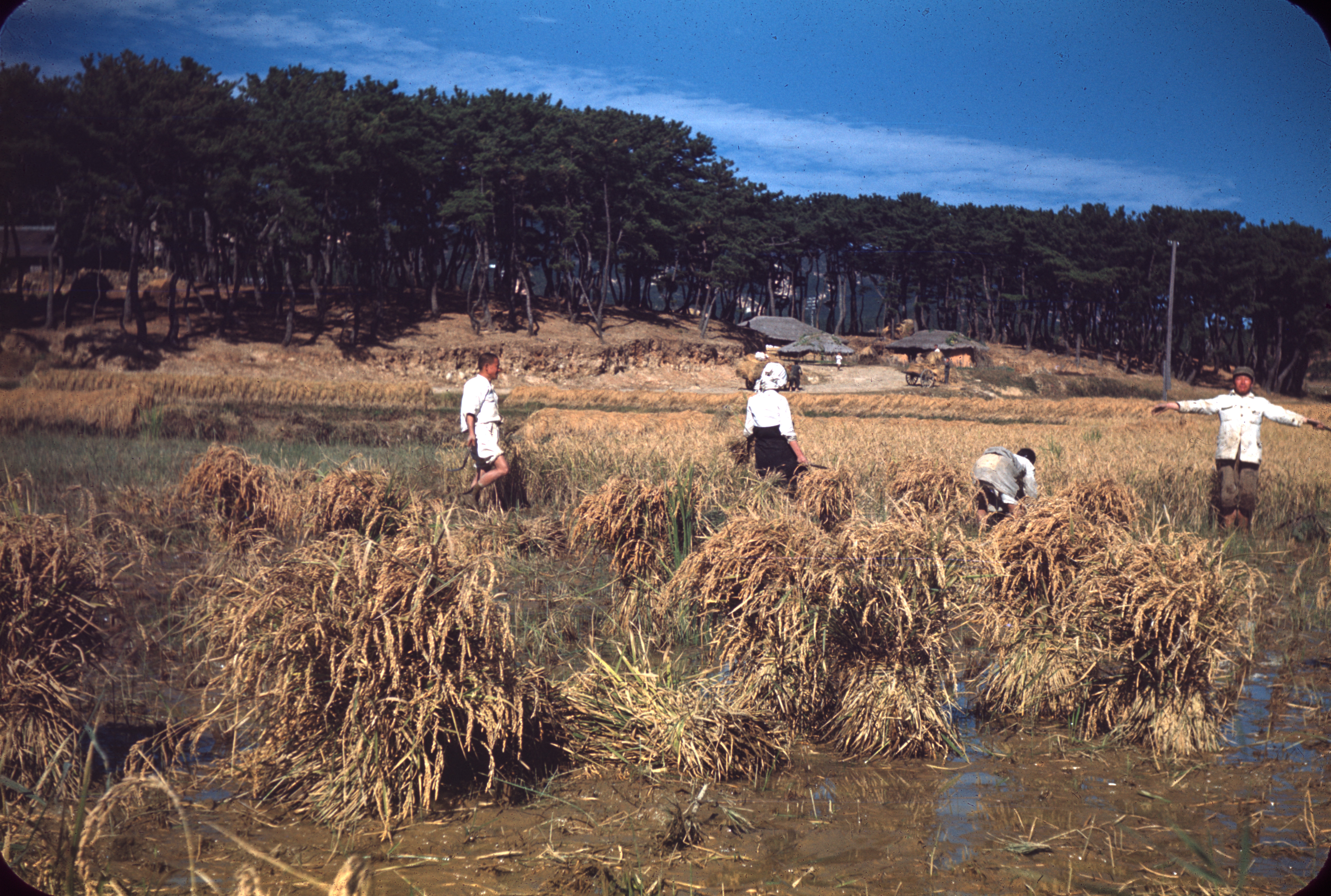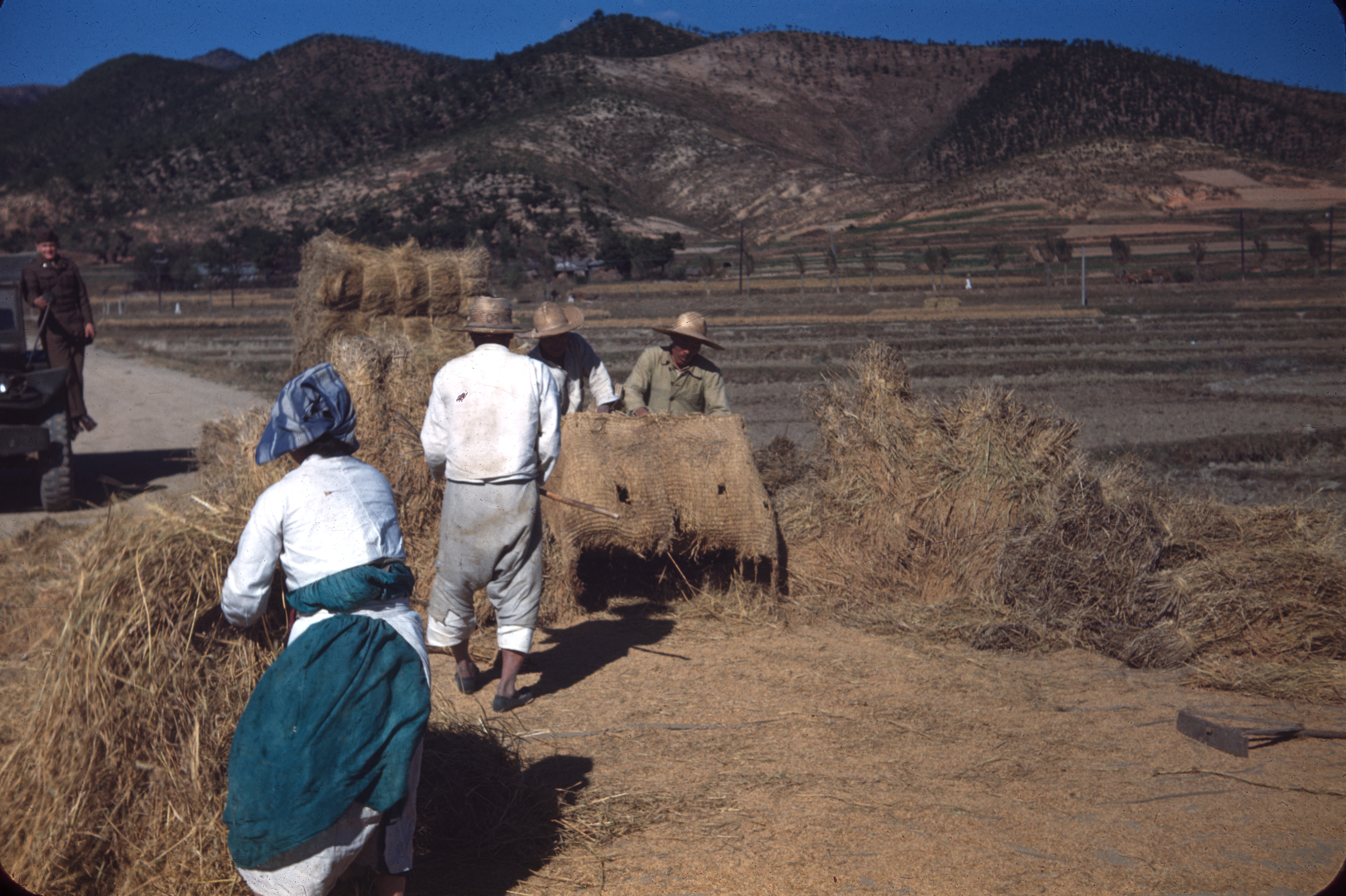Echoes of the Past
To glean. A word that smells of the earth, an ancestral gesture. That of gathering the forgotten ears of corn after the harvest, what others have left behind. After the Korean War, the wheat fields became fields of ruins, but the gesture remained. It transformed. From earth to asphalt, from ears of corn to debris, it became the symbol of the small survival jobs born of necessity.
These archives are a bridge between the rag-pickers of yesterday and the cardboard gleaners of today. They tell how, in the shadow of an economic miracle, survival reinvented itself, leaving behind traces that we will now explore.
Post-war and the emergence of gleaners
When the silence of arms succeeded three years of horror, the city was nothing but a field of ruins. Nearly 191,000 buildings, 55,000 houses, and 1,000 factories were destroyed during the Korean War (1950–1953), according to data from the Korean Central Bureau of Statistics cited in reports by the United Nations Commission for Korea (UNCURK, 1953). The streets of Seoul, once bustling with life, were now overrun with rubble, wandering children, and grieving mothers.
Immediately after the conflict, more than half of the city's inhabitants were homeless, taking refuge in gutted buildings or makeshift tents. Seoul's population then exceeded 2.5 million, partly due to the massive arrival of displaced people from the North and rural areas, seeking shelter in the capital. Poverty was endemic. The economic fabric had been pulverized, with more than 40% of industrial infrastructure annihilated. Inhabitants survived as best they could: by scavenging debris, collecting metal, paper, and fabric. Informal collection networks emerged: elderly women, widows, but also solitary children roamed the ruins, sometimes with jute bags, sometimes empty-handed, hoping to sell a few kilos of recyclable materials for a few hwan, very small sums, often barely enough to buy rice or coal, but essential for survival.
In these discreet but essential gestures, a figure emerged that would endure in Korea's social history: the waste gleaner (폐지 줍는 사람, pyeji jumneun saram). Not by choice, but out of necessity. As South Korea slowly began its reconstruction, it was in the margins, in the shadow of ruins and silence, that survival reinvented itself.
The structuring and repression of ragpickers
In the aftermath of the Korean War, in a country on its knees, a silent army organized itself on the fringes of society. These were the ragpickers: young men, orphans, displaced, or homeless, who survived by salvaging what others threw away: scraps of fabric, pieces of metal, forgotten papers. This work, born of destitution, became their sole resource in a country still unable to offer protection or employment to its most vulnerable citizens.
On July 1, 1961, the Seoul city hall organized a solemn ceremony for these men. Eight hundred of them stood at attention before civil and police authorities. They were given a role: registered scrap metal dealers, now "useful" to the nation. Behind this political gesture lay a harsher reality: from that date, those who did not register became illegal. To escape repression, one had an oath or hide.
The regime resulting from the May 16 military coup imposed strict control. Undeclared ragpickers were arrested. Adults were sent to forced labor, children placed in closed centers. Their crime: being visible on the streets, wandering, outside norms. Collecting waste was not problematic in itself; it was their poverty, their homelessness, their vulnerability that made them threatening figures to social order. The ragpickers were called “거리(에) 흩어진 악의 꽃들” (georie heuteojin agui kkotdeul): "the flowers of evil scattered in the street."
Behind these policies are stories: those of boys aged 6 to 24, separated from their families by war, passed through corrupt orphanages, rejected by a state too weakened to protect them. Some collected waste, others shined shoes or sold chewing gum. Still others begged or stole to survive. All were stigmatized.
In 1961, officially "hired" ragpickers were reorganized the following year within the Geunrojaegeondae (근로재건대 - Labor Reconstruction Corps). Some of them were then sent to various rural development programs through organizations such as the Daehan Jahwal Gaecheokdan (대한자활개척단 - National Rehabilitation Corps) founded by Kim Chun-sam or the Daehan Cheong Sonyeon Gaecheokdan (대한청소년개척단 - Youth Development Corps) also known as Seosan Gaecheokdan (서산개척단 - Seosan Development Corps). Living conditions in these corps were harsh, sometimes inhumane; those who lived outside these official structures, i.e., ragpickers who remained outside major state projects, had to evade police controls to continue collecting refuse in the streets at the risk of their freedom, some eventually turning to sorting work or managing small recycling depots (gomulsang, 고물상).
TRADUCTION_MANQUANTE: chapitre2_texte6
The fight against marginalized populations and the emergence of child vagrants
From the mid-1970s, South Korean authorities intensified their fight against marginalized populations. Ragpickers, who until then survived in collective housing or makeshift shelters, became targets of repressive policies. Their dwellings were now considered illegal: authorities evicted them, structures were destroyed, and those who persisted in occupying these spaces were sanctioned with fines. Gradually, the survival zones where these people found shelter disappeared.
And thus, buranga (부랑아, child vagrants) appeared as the direct product of post-war misery and social difficulties. Rather than considering ways to alleviate their inevitable structural instability, the South Korean state preferred to consider them as beings to be monitored and controlled, treating them as "potential delinquents" (u-beom-seong, 우범성).
TRADUCTION_MANQUANTE: chapitre3_texte3
TRADUCTION_MANQUANTE: chapitre3_texte4
TRADUCTION_MANQUANTE: chapitre3_texte5
Nanjido, the refuge of the marginalized
At the same time, a huge landfill developed northwest of Seoul: 난지도 (Nanjido). This site, initially intended to receive domestic waste from the capital, became a refuge for unregistered ragpickers. They settled there in large numbers, attracted by the abundance of recoverable materials. From the mid-1980s, even some "official" ragpickers, those who had participated in registration ceremonies in the early 1960s, joined this landfill or other peripheral collective housing areas, as state reconstruction efforts waned.
In the 1980s, Nanjido Island, west of Seoul, became a place of extreme relegation for the most precarious populations. According to a Kyunghyang Shinmun newspaper article dated July 14, 1986, it is learned that, among the mountains of waste, some families settled where there was still space: on the slopes of the landfill. The newspaper reported that 95 households then lived on this site, in a neighborhood called Beolmal. The ground was made only of piled garbage, forming a hill as high as a three-story building. There were no roads, no pipes, no real exit. "When the Nanjido landfill was completed in 1993, two mountains 98 meters high had formed in 15 years, totaling at least 92 million tons. All this waste came from Seoul (and its surroundings). A significant portion consisted of coal briquette ashes, the rest being fashion items and necessities."
Children grew up there as best they could, although they had to "step over garbage to go to school." But school was not a refuge. Students from Nanjido "suffered mockery and harassment because of their place of origin." At that time, everything was shapeless: dwellings, paths, sewers. There was "neither exit nor passable road," the daily newspaper specified. And when the rains fell, the garbage overflowed. "Residents of Gayang-dong apartments, west of Seoul, complained that they could not keep their windows open because Nanjido, an island on the other side of the Han River, served as a landfill. But many things have changed since then."
The closure of Nanjido and the erasure of memories
It was finally in 1993 that the Nanjido landfill officially closed its doors. But it was not a disappearance; it was a reconversion. That same year, the Chosun Ilbo announced the launch of a major site transformation project: Nanjido was to become an "environmental park." The mountain of garbage that had hosted tons of daily waste for more than fifteen years was destined to become a symbol of green modernity. Plans included installing sports areas, educational facilities, gardens, and even a seven-kilometer underground gas collection system to contain fermentation residues buried in the soil.
In the development plans (cf. image), everything was thought of: gas, landscape, flows, tourism. Everything except the people. No trace of Nanjido's inhabitants, no mention of those who lived there. Not a single line about the shacks, families, children, ragpickers. Memory is buried with the waste. The closure of Nanjido not only marked the end of a site; it sealed the erasure of a world. Of a parallel, informal economy, cobbled together from remnants.
However, in February 1993, an article in the Dong-A Ilbo took an interest in the fate of its inhabitants, and the title was unequivocal: "The future is blocked" 앞길 막막해요. For in Nanjido, it was not only about waste but also about human lives. Hundreds of people, nearly 400 scavengers, lived there, on the unstable slopes of a mountain of garbage in makeshift shelters. Most were elderly, disabled, or lived alone. They drew their subsistence from what the city threw away.
"It is mainly the poorest who will be affected" (가장 막막한 사람들은 노인과 장애인들). With the end of landfilling, the Seoul city hall redirected garbage to new sites in Gyeonggi-do province. Nanjido was merely a space to be rehabilitated, while nothing had been planned for those who lived there. Local sorting cooperatives, 61 in total when this newspaper was published, closed one after another. Recycling companies left, jobs disappeared, and residents remained helpless.
"The city has not planned anything for their rehousing." Among those interviewed, some had lived in Nanjido for over 15 years, often without legal status. The city hall was now asking them to "prove their worth" by working on urban reconstruction sites (수도권지적 건설현장) to hope to gain access to housing. The others would have to leave with nothing. "Most of the people here are old, sick, or disabled. Who will hire someone like me to sort garbage alone? I have lived here for 15 years. I hope the authorities will finally pay attention to the situation of the people of Nanjido. Oh Jeong-bok, 47 years old.
Thus, nothing in the plans evoked the shacks, families, cooperatives. Memory appeared nowhere, no more than the word justice. For the inhabitants of Nanjido, the real danger no longer came from waste but from oblivion.
The silent legacy of today's gleaners
Waste recovery, which had been a survival strategy born from the chaos of the Korean War, faded into silence. This work, carried out by those whom growth had left aside, allowed those who had "nothing to produce" to at least reintroduce into the industrial cycle what society rejected. But this figure of the post-war ragpicker no longer exists. It is not part of modernization narratives. It leaves no monument.
Others, however, have taken their place. Today, it is elderly, poor, widowed individuals, retirees without sufficient pensions, former invisible workers, who walk the streets, pulling carts loaded with cardboard. They sell what they can to recycling depots (gomulsang), often for a few hundred won. They are the silent heirs of those gleaners of old, but there is no longer any structure, no supervision, no recognition. Everyone fends for themselves. Alone.
There is also no police to supervise or regulate as in the 1960s. This is not progress. It is abandonment. As sociologist So Jun-cheol wrote in a 2022 article: "The ragpickers of the 60s are gone, but now in their place are the ''old people who collect old paper''…" Each walks alone, bent, pulling behind them a piece of history that no one wants to see.




